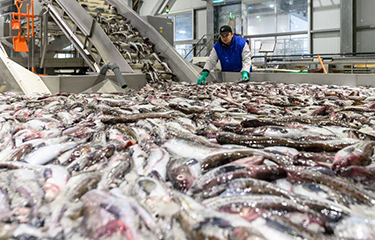Russia’s A pollock season in the Sea of Okhotsk officially started on 1 January 2024, kicking off 110 days of fishing that will collect more than 60 percent of the Far Eastern fishery basin’s landings for the year by volume.
The start of fishing in 2024 comes after a complicated year for Russia’s pollock industry in 2023, which saw higher export volumes and lower export values, according to Russian Pollock Catchers Association (PCA).
PCA President Alexey Buglak said the country will likely see a 13 percent increase in pollock export volume to 880,000 metric tons (MT) in 2023. Of that total, a huge portion went to China; according to the PCA, in the first three quarters of 2023, 473,000 MT of pollock were exported to China – a 5 percent increase year over year – but that total is still below pre-pandemic levels.
The jump in exports came on the back of increased catch. Buglak predicted Russia’s total pollock catch will exceed 1.9 million MT for 2023 and could reach as high as 1.98 million MT – a 4 percent increase year over year. The PCA predicted Russia's pollock industry will have produced up to 1.1 million MT of pollock products in 2023 – a 20 percent increase compared to 2022.
According to PCA estimates, Russian frozen headless pollock increased by 8 percent by volume compared to 2022, and whole pollock production volume increased 53 percent, according to the PCA. Fillet production, however, decreased 19 percent, and mince production declined 35 percent. Surimi production tripled to an estimated 50,000 MT, according to the PCA.
“The key trend in pollock exports this year was the reorientation from fillets to frozen pollock and surimi. In the face of declining demand and prices for fillets in Europe, Russian enterprises were forced to reconfigure production chains,” it said.
Russian pollock companies have focused on producing more surimi products. In 2021, Russian Fishery Company began debuting its surimi, a product type made possible with the completion of the first of its new supertrawler fleet in 2020.
Despite the shift in product types and the higher export volume, the value of Russian pollock exports dropped 5 percent to USD 1.2 billion (EUR 1.1 billion) in 2023 as the U.S.'s and the E.U.’s continued sanctions on the country affected prices.
Looking forward to 2024, Buglak said export markets remain volatile due to geopolitical difficulties.
“In November of this year, the European Commission decided to exclude Russian-made pollock products from the quota for duty-free imports of fish products into E.U. countries,” Buglak said. “From 1 January 2024, imports of Russian pollock fillets into the E.U., as well as second-frozen fillets produced by third countries from Russian pollock, will be subject to a duty of 13.7 percent. This will put additional pressure on the competitiveness of our products in foreign markets.”
The recent expansion of the U.S. ban on Russian seafood imports will have a smaller impact, Buglak said. The U.S. market has been "virtually closed" since 2014 – the year Russia implemented a ban on U.S. seafood – he said.
“From the point of view of distribution of supplies, this is not critical: There will be a redistribution of supply. The vacated niche in the U.S. market will be filled by Alaskan pollock, and the corresponding volume in the markets of third countries will be replaced by pollock fillets from Russia or Chinese production,” he said. “However, this decision will definitely lead to an increase in prices for pollock fillets in the U.S. domestic market and, as a consequence, for processed products since American fillets are at least one-third more expensive.”
Photo courtesy of the Russian Pollock Catchers Association







